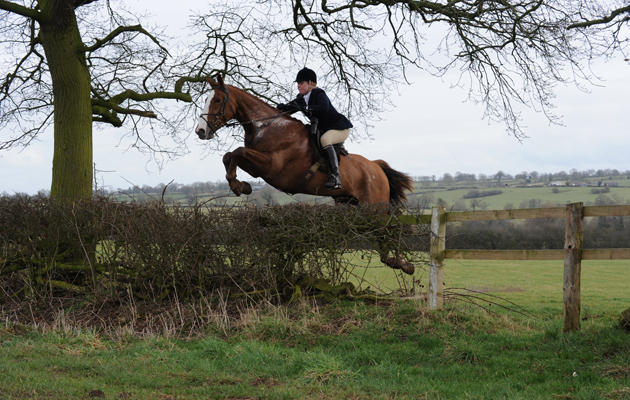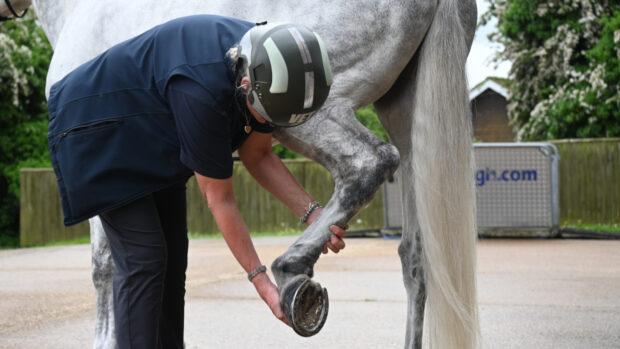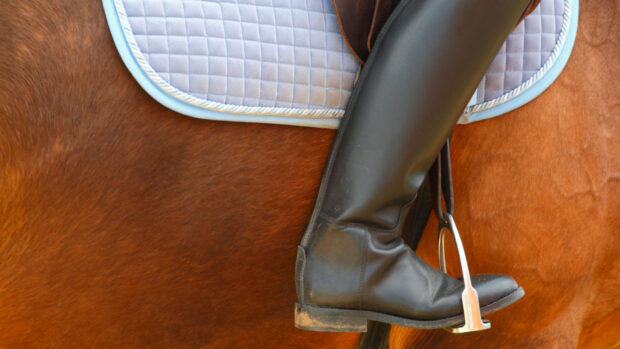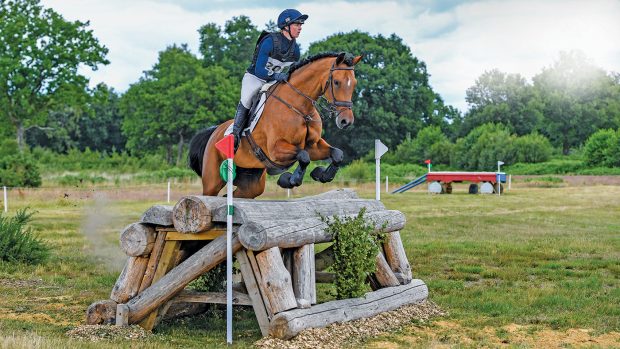Any sports horse can get hurt, but the unpredictable demands of the hunting field can result in unforeseen injury to horse, rider or both
Whether you’re hunting for the first time, or a seasoned hedgehopper, it is important to recognise where the dangers lie and how to avoid them, and if bad luck does strike, the best course of action.
Helen Van Tuyll, an equine vet and joint master of the South Dorset has been hunting since she was five-years-old and puts the majority of injuries she sees out hunting down to rider error.
“A high level of rider awareness is required when hunting. Not only must you know your hunt country, but you must also exercise a degree of common sense.”
Laura Andrews, stud groom at the BHWC for the past seven years adds: “After hunting, wash your horse off properly, check him over thoroughly for injury and deal with any accordingly.
“I also do a late check at night for chills, colic and lameness after a horse has been hunting. If you leave him until the following morning and something has gone wrong, you’re then on borrowed time. You can save thousands of pounds in vets bills, and potentially your horse’s life if you just use common sense.
“The best thing you can do is to develop a good relationship with your vet,” she adds.
“Don’t be afraid to ask questions and try to develop an understanding of various injuries. This will help keep you calm in future stressful situations.”
1. Over-reach injuries
A common injury on any hunting field, caused either by the horse clipping its own front heels with its hind legs, or a horse behind getting too close and striking the hind legs of the one in front.
Galloping fast in deep ground also carries its own risks, notes Helen. “A really bad over-reach can strike a tendon above the fetlock.”
Action: Over-reach wounds in the heel are often small, but release a surprising amount of blood. Clean thoroughly, bandage and if you think you’ve struck the tendon or the horse is displaying a high degree of lameness, call the vet.
2. Bruised soles
Concussion injuries in hunters are mainly associated with trotting on stony tracks or over stones hidden in long grass, which is often unavoidable.
Action: Good, regular shoeing is an effective preventative measure against this kind of injury and if you’re out hunting, be sensible — go home if you’ve lost a shoe and be aware of muddy tracks that might hide stones.
If your horse does come home with a bruised foot, poultice and pad the foot, and rest the horse on a deep bed so it isn’t standing on its sole. Again, if your horse is displaying a high degree of lameness, call the vet.
Continued below…

Horse & Hound’s ultimate A-Z of hunting
To celebrate this week’s hunting special of Horse & Hound magazine (26 October 2017), take a look at our A-Z
3. Flint cuts
Seen in areas such as the Chiltern Hills or by hunts such as the Kimblewick, flint is a type of rock that is so sharp, it was once used to make arrow heads in the Stone Age. Look out for flint cuts into the tendon sheath, at the back of the fetlock and cuts on the sole of the hoof.
Action: Laura advises to assess the size of cut (if your finger goes first knuckle deep into the wound, it will need a stitch), clean it and check for lameness. A small cut with a high degree of lameness needs to be looked at immediately, as does a cut of any size with any discharge. Deep cuts will need to be stitched within six hours.
4. Wire cuts
Perhaps you attempted the hunt jump and your horse ran through the wire next to the fence, or you tried jumping a ditch and got caught in a line of wire you didn’t see.
Action: Laura advises to err on the side of caution with wire cuts and call the vet. If the cut is deep, get picked up as close to the accident as you can, to save walking back through mud. “The cleaner you keep the wound, the happier your vet will be and the easier it will be to stitch,” says Helen.
5. Stone-walls
Most likely to be seen in traditional stone-wall country such as Cornwall, Derbyshire and Gloucestershire, dragging a knee or a fetlock over these sharp stones can puncture into the joint.
Action: Clean thoroughly and bandage. If you’ve caught the joint or tendon sheath, you’ll be very lame very quickly and you’ll need to get the lorry home. Helen adds: “It’s not the size of the injury, but the location of the wound that you need to be concerned about — if you’re into the joint then this is going to be a big problem. Call the vet immediately.”
6. Blackthorn
Hunts going over big hedges such as the Blackmore and Sparkford Vale see a lot of blackthorns into joints or tendon sheaths, says Helen. “Most of the time the thorn comes out, but you can’t count on that.”
Action: “If you’ve jumped hedges, and one-to-two hours afterwards your horse is non-weight bearing lame, you’ve probably picked up a thorn in the joint,” says Helen. “He will need to see a vet as soon as possible, ideally that night as it may need to be flushed.”
While you wait for the vet, try and locate where the thorn may have entered, and pull it out if it’s still embedded. Make sure you show the vet exactly where you pulled the thorn out from and mention that you’ve been jumping hedges.
Laura also advises to keep a pair of clippers and tweezers close to hand in the yard. If you’re checking your horse over and you feel a thorn under the skin, clip the area and pull it out with tweezers.
7. Suspensory ligaments
Most likely to be seen in deep clay country, check ligaments, suspensory and suspensory body and suspensory branch injuries are a common hunting injury that take a great deal of time to repair. Helen adds: “Rider awareness must come into play here — for example, don’t try to gallop over really deep ground to catch up and be cautious when jumping out of really heavy ground.”
Action: Prevention is better than cure. A good fittening programme before hunting starts will help look after legs of the horse. Laura gets the majority of fittening work done in the summer.
“First horses come in on 1 July. We do four weeks of walk work, then two weeks of trot work before continuing with mounted hound exercise and if the ground is ok, canter work. You need to make sure the legs are hard before the season starts.”
8. Kicks
Often unavoidable when horses get close on the hunting field, but as a rider it is your job to look out for potential kickers (if they are prone to it they should have a red ribbon in their tail) and do not get too close behind another horse, especially when queuing for a jump or queuing for gates.
Action: Little swelling will appear if the kick has landed on a fleshy part of the body. However, do be aware of kicks to bony areas. If he’s very lame he will need to be x-rayed. Helen adds: “If he’s been caught between the knee and elbow or kicked on the inside of the radius (where there is no flesh, just skin on bone) he may have a hairline fracture.”
9. Flesh wounds
Approaching an open gate too fast can easily result in catching a stifle on a latch or large wounds to the flanks. Partially open gates or gates that are swinging back are just as dangerous.
“Getting caught in gates is completely rider error,” says Helen. “Everything you should have learnt in Pony Club about walking through gates should apply as an adult. Even if you’re approaching a gate at a flat out gallop, always pull up, ride through the gate at a walk and check the person behind you before moving on.”
Action: “People often get very excited about big wounds, but ultimately they’re ok,” says Helen. “It’s the small pinprick wounds in awkward places over the top of joints and tendon sheaths that cause the biggest problem.”
If you have been unlucky (or stupid) enough to get caught in an open gate, travel the horse home or to the nearest veterinary clinic as quickly as possible for stitching.
10. Putting a foot down a hole
A foot down a rabbit or badger hole can result in very nasty injuries for both horse and rider. Depending on what speed you’re going at catching a limb in a hole can result in a sprained joint, pulled ligament or tendon or worse case scenario, a broken leg.
On a similar vein, be careful when riding over bridges, warns Helen. “I recently had to anaesthetise a horse so it could be lifted out of a broken bridge by a front end loader.”
Action: If you see a hole, make sure you warn others about it – this is good hunting etiquette anyway – and don’t ride over partially broken bridges, there is always another route. Also look out for recently ploughed field where the holes might be lightly covered.
If your horse has sprained a joint or pulled ligament or tendon it will need regular cold hosing, icing and box rest. Speak to your vet about getting it scanned.



